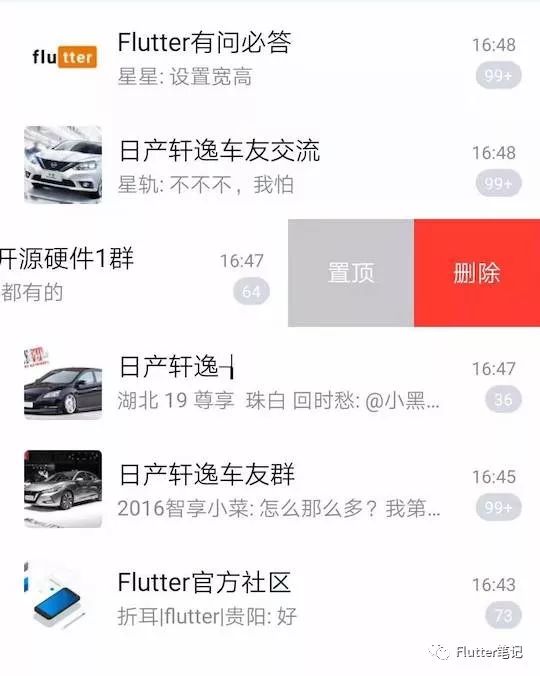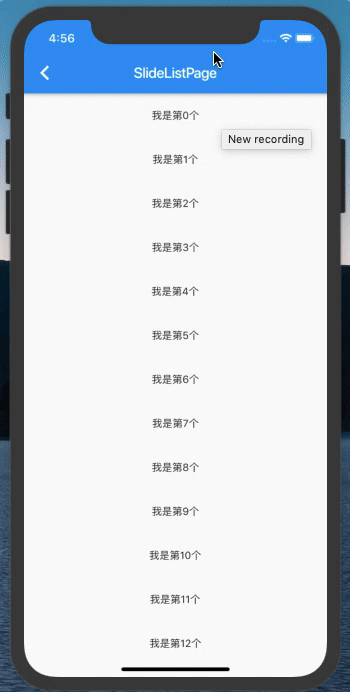Flutter | 超简单仿微信QQ侧滑菜单组件
相信大家对于这种需求肯定不陌生:
侧滑出菜单,在Flutter 当中,这种需求怎么实现?
看一下实现的效果:
需求分析
老套路,先分析一下需求:
1.首先可以滑出菜单
2.菜单滑动到一定距离完全滑出,未达到距离回滚
3.菜单数量、样式随意定制
4.菜单点击回调
5.菜单展开时,点击 item 收回菜单(见QQ)
代码实现
需求明了以后就可以写代码了。
1. 首先可以滑出菜单
最基本的,菜单要能滑的出来,我们思考一下,如何能在屏幕外面放置 Widget,并且还能滑动?
基本上不到一分钟,相信大家都能想出来答案:ScrollView,没错,也就只有 ScrollView 满足我们的需求。
说干就干:
SingleChildScrollView(
physics: ClampingScrollPhysics(),
scrollDirection: Axis.horizontal,
controller: _controller,
child: Row(children: children),
)
---------------
// 第一个 Widget,宽度为屏幕的宽度
SizedBox(
width: screenWidth,
child: child,
),1.首先把 ScrollView 滑动的位置改为横向
2.把滑动的效果改为 ClampingScrollPhysics,否则 iOS 会有回弹的效果
3.设置一个 controller,用于监听滑动距离
4.设置child 为Row,并且第一个 Widget 充满横向屏幕,这样后续的菜单就在屏幕外了
2. 菜单滑动到一定距离完全滑出,未达到距离回滚
这个效果就需要监听滑动距离和手势了。
如果滑动距离大于所有 menu 宽度的 1/4,那就全都滑出来,如果不到的话,就回滚回去。
那就要判断一下手是否已经离开屏幕,在这个时候判断距离。
本来想着套一个 Gesture,但是发现不行,问了一下大佬们,用了 Listener。
代码如下:
Listener(
onPointerUp: (d) {
if (_controller.offset < (screenWidth / 5) * menu.length / 4) {
_controller.animateTo(0, duration: Duration(milliseconds: 100), curve: Curves.linear);
} else {
_controller.animateTo(menu.length * (screenWidth / 5), duration: Duration(milliseconds: 100), curve: Curves.linear);
}
},
child: SingleChildScrollView(
physics: ClampingScrollPhysics(),
scrollDirection: Axis.horizontal,
controller: _controller,
child: Row(children: children),
),
)很简单,就是在 手抬起 的时候判断了一下距离,然后调用了 animteTo 方法。
3. 菜单数量、样式随意定制
这个其实很简单,让「用户」来传入就好了,
我只需要控制 menu 的宽度。
于是我把 Container 的参数都扒了下来,封装成了一个组件 SlideMenuItem:
class SlideMenuItem extends StatelessWidget {
SlideMenuItem({
Key key,
@required this.child,
this.alignment,
this.padding,
Color color,
Decoration decoration,
this.foregroundDecoration,
this.height,
BoxConstraints constraints,
this.margin,
this.transform,
@required this.onTap,
}) : assert(child != null),
assert(margin == null || margin.isNonNegative),
assert(padding == null || padding.isNonNegative),
assert(decoration == null || decoration.debugAssertIsValid()),
assert(constraints == null || constraints.debugAssertIsValid()),
assert(
color == null || decoration == null,
'Cannot provide both a color and a decoration\n'
'The color argument is just a shorthand for "decoration: new BoxDecoration(color: color)".'),
decoration =
decoration ?? (color != null ? BoxDecoration(color: color) : null),
constraints = (height != null)
? constraints?.tighten(height: height) ??
BoxConstraints.tightFor(height: height)
: constraints,
super(key: key);
final BoxConstraints constraints;
final Decoration decoration;
final AlignmentGeometry alignment;
final EdgeInsets padding;
final Decoration foregroundDecoration;
final EdgeInsets margin;
final Matrix4 transform;
final Widget child;
final double height;
final GestureTapCallback onTap;
@override
Widget build(BuildContext context) {
return Container(
child: child,
alignment: alignment,
constraints: constraints,
decoration: decoration,
padding: padding,
width: screenWidth / 5,
height: height,
foregroundDecoration: foregroundDecoration,
margin: margin,
transform: transform,
);
}
}这么长的代码,其实就 「width」 和 「onTap」 是自己写的。
4. 菜单点击回调
这里有个小问题:把 Menu 单独封装成了一个组件,那如何在点击 menu 的时候把 menu 收回去?
基于这个问题,在创建整个 SlideItem 的时候,通过构造函数把每一个 menu 都添加上了 GestureDetector,然后在 onTap() 回调中调用 menu 的 onTap() 方法,再调用 dismiss() 方法来收回 menu。
代码如下:
addAll(menu
.map((w) => GestureDetector(
child: w,
onTap: (){
w.onTap();
dismiss();
},
))
.toList());5. 菜单展开时,点击 item 收回菜单
也就是 菜单展开时,点击了 item 的话,要先收回菜单。QQ 就是如此。
这里有一个知识点,我们设置的点击事件默认是不会命中透明组件的,所以要给第一个默认占满屏幕宽度的 Widget 加上一个属性:behavior: HitTestBehavior.opaque。
完整的代码如下:
GestureDetector(
behavior: HitTestBehavior.opaque,
onTap: (){
if(_controller.offset != 0){
dismiss();
}else{
onTap();
}
},
child: SizedBox(
width: screenWidth,
child: child,
),
)其中 behavior 有三个值:
•deferToChild:子组件会一个接一个的进行命中测试,如果子组件中有测试通过的,则当前组件通过,这就意味着,如果指针事件作用于子组件上时,其父级组件也肯定可以收到该事件。
•opaque:在命中测试时,将当前组件当成不透明处理(即使本身是透明的),最终的效果相当于当前Widget的整个区域都是点击区域。
•translucent:当点击组件透明区域时,可以对自身边界内及底部可视区域都进行命中测试,这意味着点击顶部组件透明区域时,顶部组件和底部组件都可以接收到事件。
总结
引用群里一大佬的话:
不要把问题复杂化。
其实对于这种效果,我们仔细的想一分钟,几乎都能想出来解决方案的。而且实现起来也很简单。
本来想封装成一个 ListView 的,后来感觉没什么必要,单独封装成一个 Item 也足够用了。

